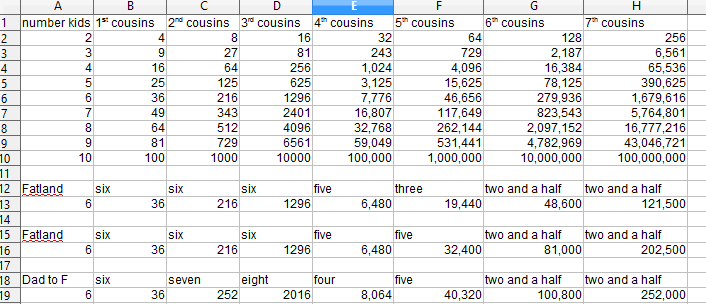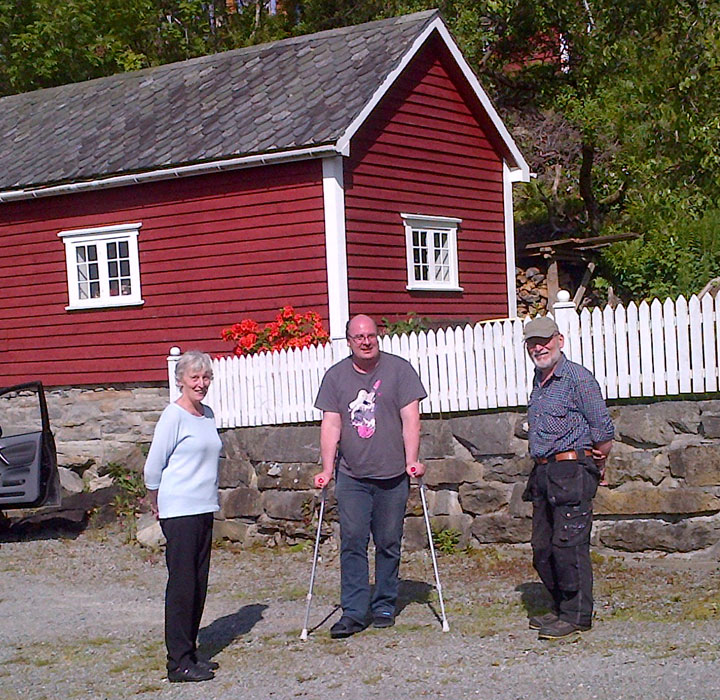Matching DNA has put me in touch with an extremely large number of Norwegian cousins who share my fifth grandparents from Fatland farm on Halsnøy Island in Hordaland, Norway. What’s more, perhaps due to the large number of them, I am seeing some triangulation of segments among their results.
This started me thinking about the effect of many generations of big family sizes on the number of sixth cousins I might have from a specific set of 5th grandparents. It would seem to me that the larger the number of cousins, the more likely it is that there are some who share good sized segments with me and Dad.
So I did a little simulation in a spreadsheet. It’s very simple, it assumes that the number of children reproducing in every generation is the same so that you can see the differences for different family sizes. I also did a line or two with the real/estimated numbers from the Fatland couple.
If your family consistently had two children who had two children reproducing for six generations you would only have 64 fifth cousins, but if everyone in your family had six children who had six children then you have almost 50,000 fifth cousins. Quite a difference!
My spreadsheet is available in my downloads area for those who wish to play with it. Download
This article in the ISOGG wiki discusses the number of expected cousins and the probability of matching DNA with them: http://www.isogg.org/wiki/Cousin_statistics
In fact it was the disconnect between those predictions and my observations of my Norwegian matches that inspired this article.
Obviously there are likely a different number of reproducing children in each generation. Back in the 1700s people had lots more children but some of them died before having children of their own. In the 1800s they still had lots of children, but far fewer died. So in the mid 1900s, many of us see our ancestors having less children to start with. My great-grandparents on this Fatland line had seven children, three of whom died in childhood in the early 1900s but in the following generations almost no children died.
So how many fifth cousins do I have from the couple whose descendants seem to be triangulating? Ole Hansen Fatland (Augnaland) 1696-1772 and Brita Monsdatter Fatland (Aksdal) 1701-1783 had seven children of whom six reproduced. Using the data on their descendants from GENI.com they had 34 grandchildren and 73 great grandchildren.
However it is unlikely that all their descendants are listed there so I did a simulation in my spreadsheet based on the six having an average of six who had an average of six based on the real world numbers I saw (some had 10, some had 5, most had 6-8).
I also tried it in the other direction, going back from my Dad to Fatland. He was the youngest of five, his mother was one of four, her father was one of eight, his mother was one of eight, her father was one of ten (but only seven are on record with children), and his mother from Fatland was one of seven with children (and yes I have X from her). By presuming the same family sizes in each older generation but 2.5 children in modern generations, I get about 100K cousins in my generation and 250K in the next generation where many of my matches are. If I match a mere 1% of them, that is still close to 3500 people who share DNA with me. Not surprising then if a few triangulate!



Your 4th cousin column formula is wrong. Whereas the columns before and after it multiply the preceding columns by the first column, the 4th cousin column multiplies 2nd cousin by 3rd cousin. The first row should read 2, 4, 8, 16, 32, 64, 128. The last row would be 10, 100, 1000, 10,000, 100,000, 1,000,000, 10,000,000.
OOPS! Thanks, let me fix that
Thank you Kitty
Saves me a some work and it will be well used (plus attributed to you) in my numerous presentations throughout New Zealand
You are welcome Gail and most welcome to use it
All you need to do is use the average population growth rate (compounded) to calculate the expected number of descendants of a couple after a fixed number of years. (presuming there is not much migration.
Fascinating article! Not to nit-pick, but maybe worth pointing out:
“If your family consistently had two children who had two children reproducing for six generations you would only have 64 fifth cousins.”
Actually, I’d have 62 fifth cousins — because two of the offspring in the 6th generation would be myself and my sibling.
I was trying to apply a variation of the formula to some real-life examples, and I kept coming up “short” — and it finally dawned on me that to get the number I needed had to add in myself and all of my siblings.
Thanks again for your great blog.
Add one more to that – it looks like we share DNA 🙂
It was funny to come across your most recent blog when I was wondering this question myself. My mother has 964 matches 4th cousins or closer (I assume that includes 4th-6th cousins as ancestry lists it), which is considerably more than my dad (338). I was also curious how many real life cousins were out there. My thinking was ancestry has 2 million participants (mostly american), and there are 320 million americans. So there might be 2mil/320mil=964/x. Which led me to about 150,000 possible real life cousins, barring any shared relatives (i know i really oversimplified things). But it still fits right nicely into your chart, between 5 and 6 children per generation.
Paula, after 3rd cousins none of the companies are accurate. So that long list of possible 4th cousins is actually more like 4th-10th cousins and so are probably a reflection of family sizes or … Endogamy? Interest in genealogy?
my gmother was born olsson @ Barkland farm in Oslo Norway Her name was Rakel. She moved to Brooklyn ny when she was 25 I live in N.C. i am proud to be a Norwegian
Lucky these ancestors of your lived in Fatland as opposed to Vest-Agder, which was so poor the kids had to walk >100 km for work. http://www.barnevandring.no/english
Fascinating site, thank you for posting that.
Another of my lines is from Vest Agder, but I have very few DNA matches on that line. Either the descendants are less interested or perhaps because the family sizes were much smaller, there are fewer cousins – being poor also meant fewer children surviving to adulthood! And yes they had become ship’s carpenters in Kristiansand.
Thanks. This article kind of relates to my dilemma…
My great-grandmother, who is ninety-one, has never known who her father was. She tested at AncestryDNA. However, I do not have access to the results because my great aunt is the administrator and she is estranged from the rest of the family. She also tested my great-grandma’s maternal first cousin, who is significantly younger, to distinguish the matches from the maternal and paternal side. So, I tested at Ancestry hoping to figure out who the father is. I have two shared matches with her that do not share any DNA with the cousin, and I confirmed this with the great aunt, even though she still won’t share the results. It is a mystery to me why she is being so secretive about them. I also found these two matches on GEDmatch. These two matches and I all share this 30.5 cM segment with each other. These two matches have one common ancestor couple. I did a surname search through my results and this couple consistently shows up in a lot of distant cousin matches’ family trees. I usually share between 10 and 20 cM with the others descended from the couple. Some of these distant cousins for me are 4th cousins or closer with my g-grandma. My thinking, based on the generations, DNA shared, and age of the matches, is that my great-grandmother’s paternal g-g-grandparents are this couple. Is this possible? Would you know how I could figure out who the father is with this information?
Thank you so much.
Jake –
You could try building a tree forward in time from that couple. Make the tree private and non-searchable. Look for someone in the right place at the right time … DNAadoption.com has documentation on this mirror tree technique.
Best if you can test your g-grandma yourself at ftDNA which has a $69 sale on and the cheek swab is way easier for old folk. Are any of her other children alive? test them too, your parents? test them. Test as many people as you can. At that sale price maybe they would even pay for their own kits!
Thank you so much. That is good advice. I have started a family tree like that. My great-grandmother is very unhappy about my great aunt even testing her in the first place. She is really depressed right now and just doesn’t want to do it. My grandmother (her daughter) thinks it is a waste of money, but my great-uncle may be willing to do it. My great aunt (the one who has my g-grandma’s results) even has an
Ancestry kit that she hasn’t taken yet. My mother is willing to do it and may do it soon. Thanks for your advice!
I may have figured it out! 🙂 There was always a family suspicion of who her father was and I match a descendant of that possible man. Is it possible for a half 1st cousin either 2x or 3x removed to share just 27 cM with each other?
If you are able to, I would have your great grandma test again. Then you would not have to worry about your great aunt sharing the results. Absolutely no disrespect is intended, but maybe the father of your great grandma is not who it was expected to be. Objectively speaking. That would explain your aunt’s reluctance. Perhaps she just likes being the gatekeeper. Good luck with your quest. It can be frustrating at times.
Yes of course it is possible. Look at the chart from Blaine Bettinger’s project at http://thegeneticgenealogist.com/2016/06/26/update-to-the-shared-cm-project/
A 1C2R is expected to share 235cM with a range of 27-413cM so halve those amounts for a half 1C2R
By the way, Ann Turner recently pointed out this article from 23andme which suggest most of us have about 4,700 5th cousins.
They also say “we think we can only detect about 4% of them [6th cousins] with 23andMe’s current technology. Our detection success is much higher for more closely related cousins, though – we can detect about 46% of 4th cousin pairs and 90% of 3rd cousin pairs.”
http://blog.23andme.com/news/announcements/how-many-relatives-do-you-have/
just stumbled upon this – I have a comment, the numbers might be accurate in a limited sense , but only if you exclude various in-laws at all levels.
for example – if parents have 2 kids , and their kids have 2 kids each, you count 4 cousins. however, each of the cousin generation marries and their spouses’ siblings also have kids which in turn are part of the cousins pools. i.e. you include only cousins who are blood descendants of the first generation. on the other hand, the numbers would reduce a bit after a while because distantly related cousins would marry each other
Yes of course. It is just a rough set of numbers. There are lots of good articles on human pedigree collapse. Try this one: http://www.gly.uga.edu/railsback/GenealComp1.html
My thought that by looking just at the descendants of my 6th grandparents there would be less collapse. I was also trying to understand why we have so many DNA matches to this one line.